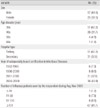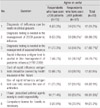Abstract
Background
The 2009 pandemic influenza (H1N1 2009) virus spread rapidly to the community after being introduced in Korea since late April, 2009. According to the health authority's revised management guideline, most of major private and public hospitals are required to take part in the medical care of pandemic influenza patients since 21 August, 2009. This questionnaire survey was conducted to identify Infectious Disease physicians' perspectives on issues related to the management of the 2009 pandemic influenza in Korea.
Materials and Methods
A 13-item questionnaire was e-mailed to 118 physicians who were board certified in Infectious Disease in November 2009. Respondents were asked about their opinion on diagnosis and treatment of influenza, and response to the pandemic influenza (H1N1 2009).
Results
The response rate was 69.5%. Of the respondents, 51.2% believed that they could make a diagnosis of influenza on clinical grounds. Most indicated that a laboratory testing is needed for the management of the pandemic and seasonal influenza (80.5% and 82.7%, respectively). Regarding the use of rapid influenza antigen test, 70.7% reported that it might be beneficial in the care of pandemic influenza patients when results are properly interpreted, and 82.9% claimed that its use during influenza seasons could reduce unnecessary antibiotic usage. These opinions were significantly higher among those who had seen more than 100 pandemic influenza patients (P=0.008 and 0.03, respectively). Evaluation using an 11-point numeric rating scale showed that respondents only moderately supported the policies and guidelines of the public health authority (mean score±standard deviation, 5.4±1.99). In view of confronting and solving the pandemic influenza (H1N1 2009), the contribution of mass media and doctors' representative organization on public health was rated as 3.5±1.89 and 3.7±1.83, respectively. The validity of media reports on the pandemic influenza was assessed as 3.3±1.71.
Conclusions
Most respondents acknowledged the need for laboratory diagnosis in the case management of suspected influenza infection. They regarded overall reactions of both governmental and non-governmental sectors in Korea to the pandemic influenza (H1N1 2009) as relatively unsatisfactory or modest at best. The results of this study showed that improvement is necessary in responses to this pandemic influenza and future seasonal influenza.
Figures and Tables
Figure 1
Opinions on the countermeasures taken by public health authority, mass media, and doctors' representative organization against the pandemic influenza (H1N1 2009).
Q9, the degree of support to policies and guidelines formulated by public health authority; Q10, the validity of contents of media reports; Q11 and Q12, the contribution of mass media and doctors' representative organization (The Korean Medical Association) in confronting the pandemic, respectively.

References
1. CDC. Outbreak of swine-origin influenza A (H1N1) virus infection - Mexico, March-April 2009. MMWR Morb Mortal Wkly Rep. 2009. 58:467–470.
2. Dawood FS, Jain S, Finelli L, Shaw MW, Lindstrom S, Garten RJ, Gubareva LV, Xu X, Bridges CB, Uyeki TM. Emergence of a novel swine-origin influenza A (H1N1) virus in humans. N Engl J Med. 2009. 360:2605–2615.

4. Kim WJ. Pandemic of novel influenza A (H1N1): Perspective and countermeasures. Korean J Med. 2009. 77:139–142.
5. Kim WJ. Novel influenza A/H1N1 pandemic: Current status and prospects. J Korean Med Assoc. 2009. 52:787–794.

6. Kim WJ. Epidemiologic and clinical characteristics of pandemic influenza (1918~2009). Infect Chemother. 2009. 14:S121–S128.
7. Gerrard J, Keijzers G, Zhang P, Vossen C, Macbeth D. Clinical diagnostic criteria for isolating patients admitted to hospital with suspected pandemic influenza. Lancet. 2009. 374:1673.

8. van Elden LJ, van Essen GA, Boucher CA, van Loon AM, Nijhuis M, Schipper P, Verheij TJ, Hoepelman IM. Clinical diagnosis of influenza virus infection: evaluation of diagnostic tools in general practice. Br J Gen Pract. 2001. 51:630–634.
9. Zambon M, Hays J, Webster A, Newman R, Keene O. Diagnosis of influenza in the community: relationship of clinical diagnosis to confirmed virological, serologic, or molecular detection of influenza. Arch Intern Med. 2001. 161:2116–2122.
10. Govaert TM, Dinant GJ, Aretz K, Knottnerus JA. The predictive value of influenza symptomatology in elderly people. Fam Pract. 1998. 15:16–22.

11. Boivin G, Hardy I, Tellier G, Maziade J. Predicting influenza infections during epidemics with use of a clinical case definition. Clin Infect Dis. 2000. 31:1166–1169.

12. Monto AS, Gravenstein S, Elliott M, Colopy M, Schweinle J. Clinical signs and symptoms predicting influenza infection. Arch Intern Med. 2000. 160:3243–3247.

13. Kim YK, Kim HY, Uh Y, Chun JK. Usefulness of rapid antigen test for novel influenza A/H1N1. Infect Chemother. 2009. 14:Suppl 2. S158.
14. Kim JY, Yoon YK, Lee CK, Cho KH, Lee KC, Sohn JW, Kim MJ. Clinical manifestation of 2009 pandemic influenza A (H1N1) infection and diagnostic usefulness of rapid antigen detection test. Infect Chemother. 2009. 14:Suppl 2. S195.
15. Heo JY, Noh JY, Jo YM, Choi WS, Song JY, Kim WJ, Cheong HJ. Clinical usefulness of a rapid antigen test for novel influenza A (H1N1) virus. Infect Chemother. 2009. 14:Suppl 2. S198.
16. Kim JS, Choi HJ, Ahn YM, Hwang YO. Clinical Usefulness of Rapid Antigen Test on the Diagnosis of Influenza. Korean J Pediatr. 2005. 48:1348–1353.
17. Lee WG, Lee HK, Kim HJ, Chung JK, Lee EH, Moon HR. Evaluation of a Rapid Antigen Test for Detection of Influenza Virus. Korean J Clin Microbiol. 2004. 7:119–123.
18. Concerning swine flu tests. Chosun Ilbo. 2009. Accessed 02 December 2009. Available at:
http://www.chosun.com/site/data/html_dir/2009/09/20/2009092000077.html.
19. Shortage of diagnostic test kits of swine flu. Dailymedi. 2009. Accessed 02 December 2009. Available at:
http://www.dailymedi.com/news/opdb/index.php?cmd=view&dbt=article&code=104312&cate=class1.
20. Korea Centers for Disease Control and Prevention. Reinforcement of daily surveillance of 2009-2010 influenza and distribution of rapid antigen detection kits. Accessed 02 December 2009. Available at:
http://www.cdc.go.kr/kcdchome/jsp/observation/influenza/out/pop/INFLMAINPOP_0909.html.
21. Sharma V, Dowd MD, Slaughter AJ, Simon SD. Effect of rapid diagnosis of influenza virus type a on the emergency department management of febrile infants and toddlers. Arch Pediatr Adolesc Med. 2002. 156:41–43.

22. Abanses JC, Dowd MD, Simon SD, Sharma V. Impact of rapid influenza testing at triage on management of febrile infants and young children. Pediatr Emerg Care. 2006. 22:145–149.

23. Poehling KA, Zhu Y, Tang YW, Edwards K. Accuracy and impact of a point-of-care rapid influenza test in young children with respiratory illnesses. Arch Pediatr Adolesc Med. 2006. 160:713–718.

24. Bonner AB, Monroe KW, Talley LI, Klasner AE, Kimberlin DW. Impact of the rapid diagnosis of influenza on physician decision-making and patient management in the pediatric emergency department: results of a randomized, prospective, controlled trial. Pediatrics. 2003. 112:363–367.

25. D'Heilly SJ, Janoff EN, Nichol P, Nichol KL. Rapid diagnosis of influenza infection in older adults: influence on clinical care in a routine clinical setting. J Clin Virol. 2008. 42:124–128.
26. Falsey AR, Murata Y, Walsh EE. Impact of rapid diagnosis on management of adults hospitalized with influenza. Arch Intern Med. 2007. 167:354–360.

27. Grijalva CG, Poehling KA, Edwards KM, Weinberg GA, Staat MA, Iwane MK, Schaffner W, Griffin MR. Accuracy and interpretation of rapid influenza tests in children. Pediatrics. 2007. 119:e6–e11.

28. World Health Organization. Clinical management of human infection with pandemic (H1N1) 2009: revised guidance. 2009. Accessed 21 November 2009. Available at:
http://www.who.int/csr/resources/publications/swineflu/clinical_management_h1n1.pdf.
29. World Health Organization. WHO recommendations on the use of rapid testing for influenza diagnosis. Accessed 21 November 2009. Available at:
http://www.who.int/csr/disease/avian_influenza/guidelines/RapidTestInfluenza_web.pdf.




 PDF
PDF ePub
ePub Citation
Citation Print
Print





 XML Download
XML Download